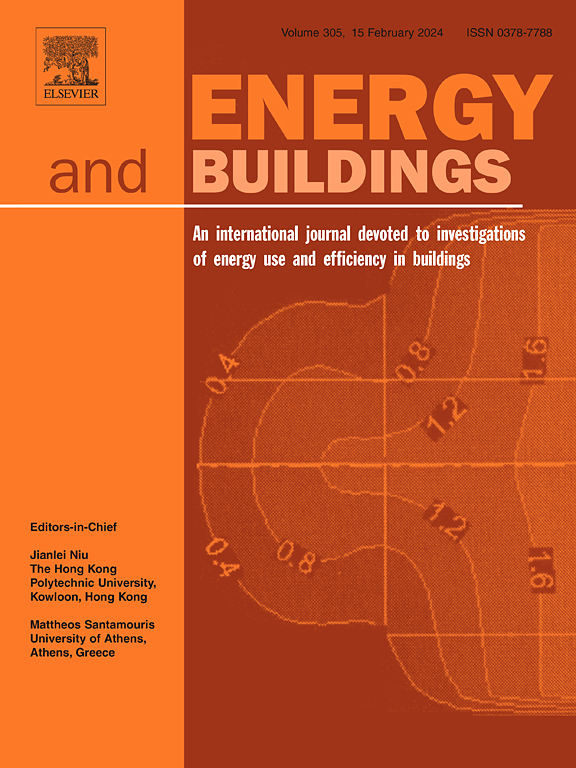Optimized design and comparative analysis of double-glazed photovoltaic windows for enhanced light harvesting and energy efficiency in cold regions of China
IF 6.6
2区 工程技术
Q1 CONSTRUCTION & BUILDING TECHNOLOGY
引用次数: 0
Abstract
This study investigates the daylighting performance and energy efficiency optimization strategies of double-glazed photovoltaic windows (DS-STPV) in cold regions of China. By conducting a comprehensive comparative analysis with traditional and energy-efficient window systems, this research aims to identify high-efficiency building solutions tailored to extreme climatic conditions. Amidst the escalating global energy demand and the pressing need for energy conservation and emission reduction, Building-Integrated Photovoltaic (BIPV) technology is increasingly recognized for its potential and value as a critical method for harnessing green energy. However, the widespread adoption of BIPV technology faces several challenges, including cost-effectiveness, conversion efficiency, system stability, and architectural aesthetic integration. Utilizing the T&A House from the 3rd International Solar Decathlon as an empirical case study, this research employs Ecotect and DesignBuilder simulation software to systematically evaluate the daylighting effect and energy performance of DS-STPV. The analysis considers various key design parameters, including photovoltaic cell coverage, window orientation, and window-to-wall ratio. Through refined modeling and multi-dimensional analysis, this study aims to identify the optimal design configurations of DS-STPV windows in cold regions, with the goal of simultaneously achieving superior natural lighting quality and significant building energy efficiency. The findings indicate that a south-facing DS-STPV window design with approximately 30% photovoltaic cell coverage and a window-to-wall ratio of 30% effectively balances daylighting requirements and energy efficiency in cold regions of China. This design strategy not only ensures an abundance of natural light in the room, but also significantly reduces the building’s energy consumption, proving the superior performance of DS-STPV windows in cold climates. In addition, the unique optical properties of DS-STPV windows reduce glare, further improving the overall quality of the indoor environment. In summary, this study provides a robust scientific foundation for the application of DS-STPV windows in cold regions, offering practical guidance and reference for optimizing energy efficiency and facilitating green transformation in future building design.
中国寒冷地区提高采光和能效的双层玻璃光伏窗的优化设计和比较分析
本研究探讨了中国寒冷地区双层玻璃光伏窗(DS-STPV)的采光性能和能效优化策略。通过与传统窗户系统和节能窗户系统进行全面对比分析,本研究旨在找出适合极端气候条件的高效建筑解决方案。在全球能源需求不断攀升、节能减排迫在眉睫的情况下,光伏建筑一体化(BIPV)技术作为一种利用绿色能源的重要方法,其潜力和价值日益得到认可。然而,BIPV 技术的广泛应用面临着一些挑战,包括成本效益、转换效率、系统稳定性和建筑美学一体化。本研究以第三届国际太阳能十项全能竞赛中的 T&A House 为实证案例,采用 Ecotect 和 DesignBuilder 仿真软件对 DS-STPV 的采光效果和能源性能进行了系统评估。分析考虑了各种关键设计参数,包括光伏电池覆盖率、窗户朝向和窗墙比。通过精细建模和多维分析,本研究旨在确定寒冷地区 DS-STPV 窗户的最佳设计配置,从而同时实现卓越的自然采光质量和显著的建筑节能效果。研究结果表明,在中国寒冷地区,光伏电池覆盖率约为 30%、窗墙比为 30% 的南向 DS-STPV 窗设计能有效平衡采光要求和能源效率。这种设计策略不仅保证了室内充足的自然光,还大大降低了建筑能耗,证明了 DS-STPV 窗在寒冷气候条件下的卓越性能。此外,DS-STPV 窗户独特的光学特性还能减少眩光,进一步提高室内环境的整体质量。总之,这项研究为 DS-STPV 窗在寒冷地区的应用提供了坚实的科学基础,为优化能源效率和促进未来建筑设计的绿色转型提供了切实可行的指导和参考。
本文章由计算机程序翻译,如有差异,请以英文原文为准。
求助全文
约1分钟内获得全文
求助全文
来源期刊

Energy and Buildings
工程技术-工程:土木
CiteScore
12.70
自引率
11.90%
发文量
863
审稿时长
38 days
期刊介绍:
An international journal devoted to investigations of energy use and efficiency in buildings
Energy and Buildings is an international journal publishing articles with explicit links to energy use in buildings. The aim is to present new research results, and new proven practice aimed at reducing the energy needs of a building and improving indoor environment quality.
 求助内容:
求助内容: 应助结果提醒方式:
应助结果提醒方式:


